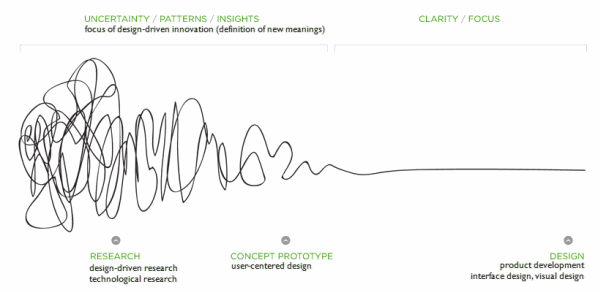Collaboration and Organization
Posted on April 4th, 2012
Once Bebe Miller had walked into the rehearsal space of our January 2012 residency with the Company I was reminded of the similarities (and differences) of collaborative structures in dance making as they relate to both design and teaching practices. Up to that point, honestly, I was not quite sure how Bebe worked as a choreographer.
Collaboration in design has evolved radically in the last 20 years as we have moved from “designer knows best” to approaches we classify as “cooperative design practices”.[1] And here at ACCAD our creative research practices and projects most often function within collaborative structures that combine multidisciplinary points of view as a way of pushing innovation through and with technology. As teachers, we think and practice through collaborative learning ideals, which reduce the teacher’s role as the sole expert in the room and instead transform that role to one of a facilitator for group learning between both teacher and students and student-to-student.
In all of these situation there exists what I thought was my brilliant term, hierarchical collaboration. This was how I defined the operational structure that Norah and I instinctively operated under in making Synchronous Objects. It turns out that Andrea Lunsford and Lisa Ede discussed this term in a 1990 article on collaborative writing.[2] As they see it “Hierarchical collaborations are projects that are clearly structured, goal-oriented, and define clear roles for its participants.”[3] While I can provide many instances in the S/O design and discovery process that can easily be categorized within those three qualities, the definition does not encompass all that is in play within Bebe’s company structure. The combination of some facets of dialogic collaborations along side of hierarchical collaboration strategies seems to best define the type of working structure for Bebe and her company.
“Dialogic collaborations are loosely structured projects which accept and often encourage members to shift roles, and often value the process of working toward the project’s goals as highly as actually attaining them. The most common adaptive strategy used in these cases is simply for the most experienced members of the team to keep the project in motion. As long as something is happening, dialogic collaborations can be kept fruitful for a very long time, even when collaborators are only able to contribute once or twice a month. “”[4]
Observing Bebe and her dancers at work, there is a definite and unspoken hierarchy in the room. Bebe is the external vision, the director who is constructing by observing, talking and moving with her dancers. This operates as the foundation for the structure that will emerge as a “work” for public performance.
Bebe and the dancers commence their work by referencing memory. By memory, I mean they rely on physical memory and experiential memory from their history together to begin exploring space, time and situation. There is a construct or conversation that they work inside of that is setup by the choreographer. Of it Bebe says. “It generally feels that there is some conceptual or larger (idea), different than just the physicality that is swimming around. That then lodges in my brain and I start…. We go into a studio. That (concept) is in my mindset and I go ‘this and not that’. I rarely make toward a thing, like trying to answer something. (I am interested in) an artful moment that is not just mine but for us all. All of that sort of floats together and becomes directional.”[5]
To a non-dancer like me, this interaction looks very loose and non-structured. But soon I come to realize this period as similar to the initial stages of the design process that designers refer to as the “fuzzy front end” or the idea generation stage. Designer Damien Newman explains:
“Broadly speaking, the fuzzy front end is defined as the period between when an opportunity for a new product is first considered, and when the product idea is judged ready to enter “formal” development. Our understanding of the fuzzy front end is still limited. Relatively little is known about the key activities that constitute the fuzzy front end, how these activities can be managed, which actors participate, as well as the time needed to complete this phase. The fuzzy front end is a crossroads of complex information processing, tacit knowledge, conflicting organizational pressures, and considerable uncertainty and equivocality.”[6]
From within this fuzzy front end and with intention applied, the choreographer begins to guide or direct the dancers based on what she is reading in the movement. For Bebe choreography is “less about which movement it is but about what are the parameters of the movement – when does it happen in relationship to what? It’s how I have evolved choreographically. Choreography is choreographing the space in time. Not just specifically where the body is. Choreographing a set of circumstances in situations.”
To direct the form, Bebe begins to make choices and to layer those choices together. These directions, in Bebe’s words, serve to “interrupt the inevitable”. This is the part of the process we will get to experience and explore as we continue to watch A History emerge.
– maria
[1] Sanders, Liz and Bo Westerlund, Experiencing, Exploring and Experimenting In and With Co-Design Spaces. Nordic Design Research Conference 2011, Helsinki, http://www.maketools.com/papers.html
[2] Lunsford, Andrea, and Lisa Ede. Singular Texts/Plural Authors: Perspectives on Collaborative Writing. Carbondale: Southern Illinois UP, 1990, p. 134.
[3]Meta Collab. Hierarchical Collaboration. http://collaboration.wikia.com/wiki/Hierarchical_collaboration <January 20, 12>
[4]Meta Collab. Dialogic Collaboration. http://collaboration.wikia.com/wiki/Dialogic_collaboration <January 20, 12>
[5] Recording from January 11-14 Residency of BMC at ACCAD, The Ohio State University. (from mp3 file Fri-All6, starts @ 03:14)
